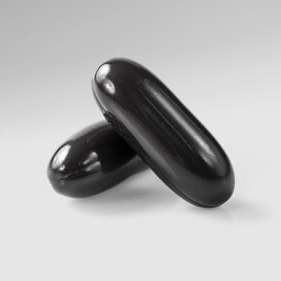BACKGROUND
Ingredient Type: Vitamin
Also Known As: Antiscorbutic vitamin, Ascorbate, Ascorbic Acid, Ascorbyl Palmitate, Calcium Ascorbate, Cevitamic Acid, Iso-Ascorbic Acid, L-Ascorbic Acid, Sodium Ascorbate (1)
Vitamin C is an essential nutrient for all animals, obtained only through the diet. It is essential for human survival. Natural sources include fruits and leafy vegetables. Vitamin C is required for the biosynthesis of collagen, L-carnitine, and certain neurotransmitters, and it is in involved in protein metabolism. Collagen is an essential component of connective tissue, which plays a vital role in wound healing. In addition to its biosynthetic and antioxidant functions, vitamin C plays an important role in immune function and improves the absorption of nonheme iron. Deficiency causes scurvy, which is characterized by fatigue, widespread connective tissue weakness, and capillary fragility. (2).
Historically (1500-1800) vitamin C deficiency (scurvy) caused the death of an estimated 2 million sailors. In 1753 James Lind observed that by eating oranges, lemons and fresh green vegetable scurvy could be prevented. Albert Szent-Györgyi and Charles Glen King isolated vitamin C from adrenal glands and lemon juice in 1932. In 1970 significicant research prompted on Vitamin C after Linus Pauling published a book showing benefits of Vitamin C use in preventing and decreasing the symptoms of the common cold. (1)
TRADITIONAL USES
Orally, vitamin C is used for preventing and treating scurvy, as well as preventing vitamin C deficiency in people with gastrointestinal diseases and those on chronic total parenteral nutrition or chronic hemodialysis. Vitamin C is also used for increasing iron absorption from the gastrointestinal tract; and increasing the healing rate of wounds, burns, fractures, ulcers, pressure sores, and sunburn. It is used for urine acidification, preventing lead toxicity, bowel preparation side effects, treating idiopathic methemoglobinemia, treating albuminuria, correcting tyrosinemia in premature infants on high-protein diets, increasing iron excretion (in combination with deferoxamine), preventing and treating the common cold and other viral infections, age-related macular degeneration (AMD), bronchitis, human immunodeficiency virus (HIV) disease, Helicobacter pylori infection, tuberculosis, dysentery, furunculosis, hematuria, retinal hemorrhages, hemorrhagic states, and anemia. Vitamin C is also used orally for cardiovascular disease, atherosclerosis, preventing vascular thrombosis, postoperative atrial fibrillation, nitrate tolerance, myocardial infarction, chronic venous insufficiency, stroke, hypertension, lowering cholesterol, glaucoma, preventing cataracts, preventing gallbladder disease, complex regional pain syndrome following surgery or injury, dental caries, dental plaque, pyorrhea, gum infections, constipation, peptic ulcer, acne, erythema, atopic disease, improving immune function, swine flu, allergic rhinitis, asthma and exercise-induced asthma, bronchitis, cystic fibrosis, sickle cell disease, cystitis, prostatitis, urinary tract infections (UTIs), infertility, diabetes, peripheral neuropathy, and pre-eclampsia or other pregnancy-associated complications. It is also used orally for depression, cognitive impairment, vascular dementia, Alzheimer’s disease, physical and mental stress, fatigue, attention deficit-hyperactivity disorder (ADHD), chronic fatigue syndrome (CFS), autism, schizophrenia, collagen disorders, idiopathic sudden sensorineural hearing loss (ISSHL), amyotrophic lateral sclerosis (ALS, Lou Gehrig’s disease), Parkinson’s disease, osteoarthritis and bursitis, postoperative pain, back pain and disc inflammation, tendinopathy, fractures, cancer, osteogenesis imperfecta, osteoporosis, and gout. Other uses include improving physical endurance and performance, Lyme disease, tetanus, reducing aging, heat prostration, for counteracting the side effects of cortisone and related drugs, reducing contrast-mediated nephropathy, aiding drug withdrawal in addiction, and in the treatment of levodopa, succinylcholine, interferon, aspirin, and arsenic toxicity. Other uses include use as an adjunct to radiation therapy and treating chronic radiation proctitis. It is also used to prevent human immunodeficiency virus (HIV) transmission to breast-fed babies (4).
WHAT DOES SCIENCE TELL US?
Atrial fibrillation. An analysis of clinical research shows that taking vitamin C 1-2 grams daily for 1-3 days prior to cardiac surgery followed by 1-2 grams in two divided doses daily for 4-5 days after cardiac surgery reduces the risk of postoperative atrial fibrillation by about 30%. It was also shown to shorten the duration of hospitalization compared with control (6). In a clinical trial, taking vitamin C 1 gram daily along with vitamin E 400 IU daily and 2 grams daily of eicosapentaenoic acid (EPA) and docosahexaenoic acid (DHA) in a 1:2 ratio beginning 2 days prior to cardiac surgery and continuing until hospital discharge reduces the risk of postoperative atrial fibrillation by about 70% compared with control (7)
Hypertension. Taking vitamin C orally along with conventional antihypertensive medications appears to modestly decrease systolic blood pressure, but the effects on diastolic pressure are mixed (8).
Nitrate tolerance. Taking vitamin C orally seems to prevent the development of nitrate tolerance in patients taking sublingual nitroglycerin. There is some evidence that short-term vitamin C supplementation can prevent attenuation of tolerance to the vasodilatory effects of nitrates (9).
Atherosclerosis. Some clinical research shows that taking a specific combination product containing slow-release vitamin C 250 mg and vitamin E 136 IU twice daily modestly slows the 3-year progression of atherosclerosis of the carotid artery in men, but not in women (10)
Overall mortality. Population research suggests that plasma vitamin C levels are positively associated with a reduced risk of mortality from all causes (11).
Cardiovascular disease. Some large population studies have shown a reduction in mortality from coronary heart disease either from dietary sources or supplements (12, 13, 14). According to one analysis, supplemental vitamin C, but not dietary vitamin C, is associated with a reduced risk of cardiovascular disease (15). A Science Advisory from the American Heart Association also states that the evidence does not justify the use of antioxidants such as vitamin C for reducing the risk of cardiovascular disease (16).
SAFETY
Considered safe when it is used orally, topically, intramuscularly, or intravenously and appropriately. (5)
REFERENCES
- Monographs on the medicinal uses of plant drugs. Exeter, UK: European Scientific Co-op Phytother, 1997
- Padayatty SJ, Katz A, Wang Y, et al. Vitamin C as an antioxidant: evaluation of its role in disease prevention. J Am Coll Nutr. 2003;22(1):18-35.
- Chatterjee IB, Mukhopadhyay CK, Ghosh MK. Vitamin C: A potential savior against free radical-induced oxidative damage. Curr Sci. 1995;69(9):747-751.
- Https://Naturalmedicines.therapeuticaresearch.com
- McEvoy GK, ed. AHFS Drug Information. Bethesda, MD: American Society of Health-System Pharmacists, 1998.
- Ali-Hassan-Sayegh S, Mirhosseini SJ, Rezaeisadrabadi M, et al. Antioxidant supplementations for prevention of atrial fibrillation after cardiac surgery: an updated comprehensive systematic review and meta-analysis of 23 randomized controlled trials. Interact Cardiovasc Thorac Surg 2014;18(5):646-54
- Rodrigo R, Korantzopoulos P, Cereceda M, Asenjo R, Zamorano J, Villalabeitia E, Baeza C, Aguayo R, Castillo R, Carrasco R, Gormaz JG. A randomized controlled trial to prevent post-operative atrial fibrillation by antioxidant reinforcement. J Am Coll Cardiol. 2013 Oct 15;62(16):1457-65.
- Juraschek, S. P., Guallar, E., Appel, L. J., and Miller, E. R., III. Effects of vitamin C supplementation on blood pressure: a meta-analysis of randomized controlled trials. Am J Clin.Nutr 2012;95(5):1079-108
- Daniel TA, Nawarskas JJ. Vitamin C in the prevention of nitrate tolerance. Ann Pharmacother 2000;34:1193-7
- Salonen RM, Nyyssonen K, Kaikkonen J, et al. Six-year effect of combined vitamin C and E supplementation on atherosclerotic progression: the Antioxidant Supplementation in Atherosclerosis Prevention (ASAP) Study. Circulation 2003;107:947-53
- Khaw KT, Bingham S, Welch A, et al. Relation between plasma ascorbic acid and mortality in men and women in EPIC-Norfolk prospective study: a prospective population study. European Prospective Investigation into Cancer and Nutrition. Lancet 2001;357:657-63
- Ramirez J, Flowers NC. Leukocyte ascorbic acid and its relationship to coronary artery disease in man. Am J Clin Nutr 1980;33:2079-87.
- Kritchevsky SB, Shimakawa T, Tell GS, et al. Dietary antioxidants and carotid artery wall thickness. The ARIC Study. Atherosclerosis Risk in Communities Study. Circulation 1995;92:2142-50.
- Nyyssonen K, Parviainen MT, Salonen R, et al. Vitamin C deficiency and risk of myocardial infarction: prospective population study of men from eastern Finland. BMJ 1997;314:634-8
- Knekt P, Ritz J, Pereira MA, et al. Antioxidant vitamins and coronary heart disease risk: a pooled analysis of 9 cohorts. Am J Clin Nutr 2004;80:1508-20
- Kris-Etherton PM, Lichtenstein AH, Howard BV, et al. AHA Science Advisory: Antioxidant vitamin supplements and cardiovascular disease. Circulation 2004;110:637-41
See the National Institutes of Health Office of Dietary Supplements entry for vitamin C, the MedlinePlus entry for ascorbic acid, this University of Florida article on vitamin C, the Mayo Clinic entry for vitamin C, the Examine.com entry for vitamin C, or the RXList entry for vitamin C for more information.









